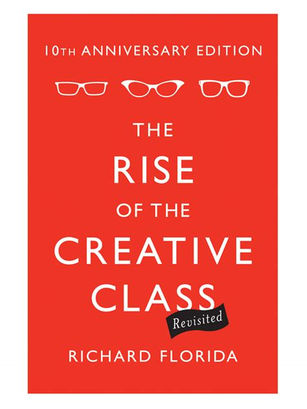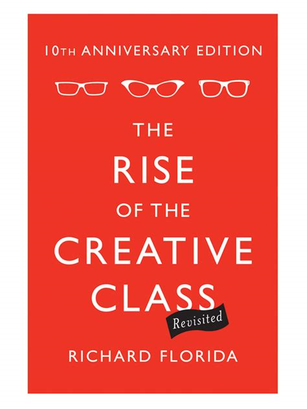|
This is the third of three essays on Richard Florida’s book: The Rise of the Creative Class  Richard Florida paints a fairly rosy picture of the Creative Class and the future of cities. Obviously there will be challenges and problems to solve, but the more people we can add to the creative class, and the more we can structure our cities to cater to and support the creative class, the better off we’ll be. From an economic standpoint, this is difficult to argue with because there is not much of an alternative. Rebuilding the working class is not possible (nor is it desirable). The service class continues to grow, but it is not likely to create large amounts of wealth for most of those in it. At best, it can reward some talented people highly, while most of the low-paying service jobs like fast food workers, cashiers, shelf stackers, etc. become transitory positions for younger people as they work towards more lucrative careers. Modern technology and innovation dramatically increase the economic returns to those who know how to use them. This fact explains a good amount of the income and wealth gap we see between the top and the bottom of the distributions. Florida seems to hope that we can keep adding more and more people to the top of that distribution and reduce the number in the bottom part. While I find that plausible, I also have serious doubts about how well that distribution can be changed by adding folks to the creative class or whether we can do so. But the deeper challenge of the Creative Class is cultural, social, and philosophical. There are several striking social trends that seem to be driven by the Creative Class. One trend observed decades ago by Robert Putnam in Bowling Alone, was increasing social isolation. There has been a massive increase in the number of people living alone - which has gone hand in hand with declining involvement in clubs, associations, and even traditional family life. Florida describes Putnam’s findings:
2 Comments
Cities and the Creative Class2/24/2021 This is the second of three essays on Richard Florida’s book: The Rise of the Creative Class  As I mentioned in my previous essay, the creative class tends to congregate in cities. There are many reasons for this: greater intellectual stimulation and diversity, more amenities to enjoy (which also contribute to creativity), and greater tolerance in general of eclectic, heterodox, or even outrageous strange lifestyles, ideas, and beliefs. Urban areas create a milieu of all these different ideas and creative people find challenge and inspiration as they navigate it. Over time, the trends and ideas of the creative class tend to radiate outward into the rest of society (see To Change the World by James Davison Hunter for a nice analysis of how cultural change happens). One of the striking cultural shifts brought about by the Creative Class is a blending of work and leisure. Cities contribute to both. Regarding work, cities boost people’s creativity. They run into more people and different kinds of people than if they were in rural areas. They are constantly seeing new ideas and products coming from competitors. Within their own circles, they can contribute to others projects while also building on what others have done or are working on. At some level, there is a significant amount of serendipity involved in the process – you never know what exact situation, conversation, or idea will spark a burst of creative energy and innovation. The Creative Class2/19/2021 This is the first of three essays on Richard Florida’s book: The Rise of the Creative Class Richard Florida teaches management and economic development at the University of Toronto and New York University. He also taught at Carnegie Mellon for over a decade. His research focuses on prosperity, especially as it relates to the kinds of work people do and the kinds of places they live. He has written several books about the new “creative class” that powers the modern economy:
So, what is the creative class and why is it important?  Florida identifies three major classes of workers in the United States: the working class, the service class, and the creative class. The working class consists of traditional blue collar labor in factories and manufacturing. The number of people doing blue collar work has been declining since the middle of the 20th century. That decline (in employment, not output) will almost certainly continue. The service class, however, has grown substantially over the past four decades. These folks generally have less skill and education than creative class workers. They also generally make less money, are less geographically concentrated, and are less mobile. Although the number of people working in the service industry is on an upward trajectory, it is growing more slowly than the third class of creative workers. Somewhere around 35%-40% of workers are in the creative class. Not only is the creative class growing faster than the service and working classes, it is also the most highly paid, most satisfied class of workers. Florida suggests that we should actively encourage and hope that more and more people can enter the creative class because it is superior to the others, not just economically, but in terms of quality of life and happiness. Dietrich Bonhoeffer wrote this book while spending several years running an “illegal” seminary in Germany (~1935-1938). He describes what life in a Christian community ought to be. The influence of Martin Luther weighs heavily throughout the whole book, and those not familiar with the Lutheran tradition (including myself) will likely be struck by some of the themes and ideas Bonhoeffer presents of a strongly Lutheran character. Life Together contains five chapters: Community, The Day with Others, The Day Alone, Ministry, Confession and Communion. I’ve been challenged and inspired and convicted by what Bonhoeffer says.
Chapter 1: Community Bonhoeffer begins the chapter on Community by noting the amazing blessing of being able to gather with other believers. Many Christians, he claims, walk a lonely road whether on the mission field, in prison, under persecution, or in the isolation of infirmity and age: “Let [the Christian] thank God on his knees and declare: It is grace, nothing but grace, that we are allowed to live in community with Christian brethren.” Bonhoeffer, like Luther, also takes a strong stand against isolated monastic life removed from the cares and concerns of the world: “So the Christian, too [like Christ], belongs not in the seclusion of a cloistered life but in the thick of foes.” Bonhoeffer also emphasizes that Christ is at the center of Christian fellowship. It is for Christ’s sake that we need others, and it is in Christ alone that we approach others. The centrality of Christ in Christian fellowship, while seemingly obvious, takes on a striking severity for Bonhoeffer: “What determines our brotherhood is what that man is by reason of Christ. Our community with one another consists solely in what Christ has done for both of us.” Desiring more from community than fellowship in Christ detracts from a truly Christian fellowship: “One who wants more than what Christ has established does not want Christian brotherhood. He is looking for some extraordinary social experience which he has not found elsewhere; he is bringing muddled and impure desires into Christian brotherhood….In Christian brotherhood everything depends upon its being clear right from the beginning, first, that Christian Brotherhood is not an ideal, but a divine reality. Second, that Christian brotherhood is a spiritual and not a psychic reality.” Bonhoeffer highlights the common pitfalls of unrealistic and unrighteous expectations of the church. He talks about the “wish-dream” that people have about other believers and the Christian community. In the ideal church people would (fill in the blank): “invite me over,” “help me get a job,” “provide me with friendship,” “affirm my choices or lifestyle,” “give me a spouse,” etc. Bonhoeffer emphasizes that the church exists for Christ and by his will. It exists as it is – with a spiritual existence – not to satisfy our various dreams, desires, or hopes. As he notes: “The man who fashions a visionary ideal of community demands that it be realized by God, by others, and by himself. He enters the community of Christians with his demands, sets up his own law, and judges the brethren and God Himself accordingly.” Throughout the book, Bonhoeffer is concerned about the pollution of impure desires, the risk of domination/manipulation, and unrealistic hopes and expectations of Christian fellowship. He also contrasts Christian community with human community. He writes: “Christian brotherhood is not an ideal we must realize; it is rather a reality created by God in Christ in which we may participate….[But] [t]he basis of all human reality is the dark, turbid urges and desires of the human mind. The basis of the community of the Spirit is truth; the basis of human community is desire.” And later he writes: “Human love lives by uncontrolled and uncontrollable dark desires; spiritual love lives in the clear light of service ordered by the truth. Human love produces human subjection, dependence, constraint; spiritual love creates freedom of the brethren under the Word.” I find it interesting that Bonhoeffer seeks to exorcise human desire from Christian community – and I am unsure whether I can go along with such a sentiment. It seems to me that he is reacting both to Romanticism (which had a particularly strong and powerful legacy in Germany – think Richard Wagner) and to an increasingly psychological view of the world (think Sigmund Freud). Bonhoeffer also worries about the will to dominate others and the exercise of power. He talks about how, in contrast to Christian community where “God’s Word alone is binding,” in human community “men bind others to themselves.” Instead of relying on the work of the Spirit, “in human community, psychological techniques and methods” are used to govern or manipulate others. As he discusses this further, Bonhoeffer sounds remarkably like C. S. Lewis in his works Till We Have Faces and The Screwtape Letters, which talk about the corruption of love – or really a kind of love that has become a demon (as Lewis describes Eros in The Four Loves) and attempts to dominate, control, or even absorb others into oneself. In fact, Bonhoeffer writes: “Thus there is such a thing as human absorption” because “human community expresses a profound, elemental, human desire for community, for immediate contact with other human souls, just as in the flesh there is the urge for physical merger with other flesh. Such desire of the human soul seeks a complete fusion of I and Thou, whether this occur in the union of love or, what is after all the same thing, in the forcing of another person into one’s sphere of power and influence.” This brings us back to the emphasis on Christ. He is the mediator of Christian community. Our unity is not one of dominating others or “absorbing” them to be like us. Rather, we are all being brought into Christ, being transformed into his likeness. Since Christ is the head of the Church, and the only source of authority, we are all on equal footing. And our community is governed by Him, not by merely human sentiment, emotion, or desire. As Bonhoeffer describes it: “Human love is directed to the other person for his own sake, spiritual love loves him for Christ’s sake. Therefore, human love seeks direct contact with the other person; it loves him not as a free person but as one whom it binds to itself. It wants to gain, to capture by every means; it uses force. It desires to be irresistible, to rule.” Although I have some hesitation about this view, it explains nicely why what parades as human love quickly turns to hate when the object of human love either refuses to go along with our wishes or disappoints us through sin or through being drawn to some other person or object other than ourselves. Bonhoeffer says: “This is why human love becomes personal hatred when it encounters genuine spiritual love, which does not desire but serves. Human love makes itself an end in itself. It creates itself as an end, an idol which it worships, to which it must subject everything. It nurses and cultivates an ideal, it loves itself, and nothing else in the world. Spiritual love, however, comes from Jesus Christ, it serves him alone; it knows that it has no immediate access to other persons. Jesus Christ stands between the lover and the others he loves.” Again, for those of you familiar with Lewis’ work, this sounds exactly like his description of Eros in The Four Loves. His novel, Till We Have Faces, dramatizes this whole process of love, possession, and hatred. The biblical story of Amnon and Tamar also illustrates this idea. Bonhoeffer concludes his first chapter: “It is not the experience of Christian brotherhood, but solid and certain faith in brotherhood that holds us together….For Jesus Christ alone is our unity. ‘He is our peace.’ Through him alone do we have access to one another, joy in one another, and fellowship with one another.” AuthorPaul Mueller is a Senior Research Fellow at AIER, a research fellow and associate director for the Religious Liberty in the States project at the Center for Religion, Culture, and Democracy, and the owner and operator of The Abbey Bed and Breakfast. Archives
August 2021
Categories |

 RSS Feed
RSS Feed
